إغلاق المشروع هو جزء لا يتجزأ من إدارة المشروع. إنها المرحلة النهائية التي يتم فيها اختبار المخرجات مقابل مؤشرات الأداء الرئيسية والنطاق ، يتم ربط الأطراف السائبة، ويتم تعلم الدروس المستفادة، ويكتمل التسليم، ويتم التوقيع على المشروع.
من نواحٍ عديدة، فإن إغلاق المشروع لا يقل أهمية عن اجتماع الانطلاق و نطاق العمل (SOW). إنه شيء يجب على المديرين تخصيص وقت له لضمان ما يلي مخرجات المشروع قد اكتملت كما هو متوقع وأن تم تنفيذ المشروع بنجاح .
في هذا المنشور، سنرشدك في هذا المنشور إلى عملية إغلاق المشروع خطوة بخطوة ونقدم لك خمسة نماذج مفيدة يمكنك استخدامها لتبسيط عملية إغلاق المشروع لفريقك.
ما هو إغلاق المشروع؟
سواء كان المشروع داخليًا أو يتم تسليمه بالتعاون مع طرف ثالث، مثل شركة تطوير برمجيات أو وكالة تسويق، يجب أن ينتهي دائمًا بمرحلة إغلاق المشروع.
إغلاق المشروع هو المرحلة الأخيرة ذات الأهمية الحاسمة في المشروع إدارة المشروع دورة الحياة. وهو يمثل نهاية المشروع، وهو آخر مؤشر الأداء الرئيسي قبل أن تبدأ أي مخرجات في إحداث تأثير على المؤسسة.
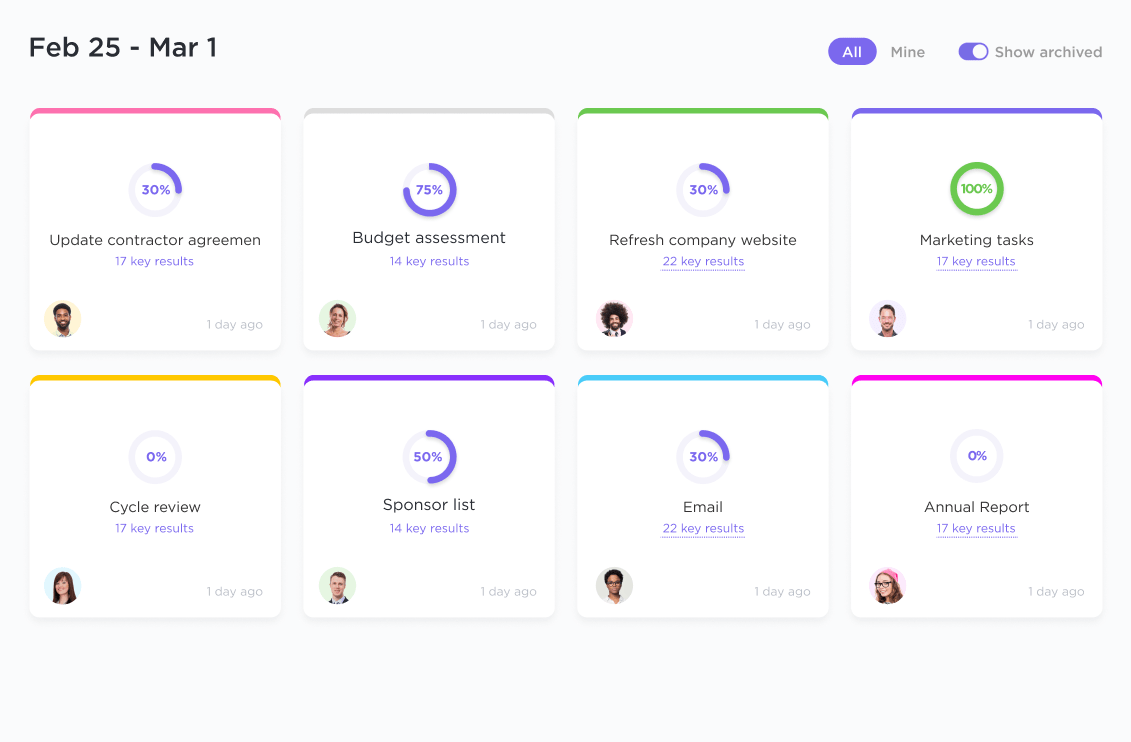
تتبع أهدافك وصولاً إلى مؤشرات الأداء الرئيسية الأكثر أهمية واحصل تلقائيًا على مشاهدات مفصلة عن تقدمك
على سبيل المثال، إذا كان الهدف هو طرح برنامج جديد لإدارة علاقات العملاء في مؤسسة ما، فقد يستغرق ذلك وقتًا، خاصةً إذا كان الطرف الثالث البائعين أو الاستشاريين متورطون.
ومع ذلك، فإن الأمر يستحق أخذ الوقت اللازم: معظم المشاريع (من أي حجم) تعمل بسلاسة أكبر بكثير عندما يكون هناك برنامج لإدارة المشاريع لإبقاء الجميع على رأس العمل والتركيز وعلى نفس الصفحة.
لماذا يعتبر إغلاق المشروع مهمًا؟
يمكن أن يساعد الاختتام الفعال للمشروع في تحديد ثقافة الفريق. كل ما يتعلمه عضو الفريق أو قائد المشروع من تنفيذ المشروع وتسليمه⏤ من نجاحات وإخفاقات⏤ يمكن الاستفادة منه في المشاريع المستقبلية.
من المهم بنفس القدر التأكد من تمرير الوثائق والأصول والمخرجات الأخرى إلى العميل والتوقيع عليها. وبخلاف ذلك، يمكن للعميل أن يقول إن المشروع لم يكتمل كما هو متوقع، خاصةً إذا كانت تلك الأصول مدرجة في العقد.
يتضمن إغلاق المشروع الإجابة على عدد قليل من الأسئلة للتأكد من أن كل شيء قد تم الانتهاء منه، بما في ذلك:
- هل تم تحقيق الأهداف والغايات؟
- هل العميل راضٍ عن وثائق المشروع ومخرجاته؟
- هل تم إنجاز المشروع بشكل صحيح في الوقت المحدد وفي حدود الميزانية؟
- هل هناك أي دروس مستفادة من أي اختناقات أو مشاكل في منتصف العملية من شأنها أن تكون مفيدة لفرق المشروع المستقبلية؟
- هل كبار القادة والمدراء أو أصحاب المصلحة الآخرين راضون عن نتائج المشروع؟
- ما العائد على الاستثمار الذي يمكن توقعه، أو ما هو العائد على الاستثمار الذي سيختبره العميل بعد إغلاق المشروع؟
- للرجوع إليها في المستقبل - هل كان الأمر يستحق الوقت والجهد والمال المستثمر؟
- الآن بعد أن تم تسليمه، هل أصحاب المصلحة والموظفون الذين سيستخدمون الناتج (على سبيل المثال، تطبيق برمجي جديد) على دراية به وتدريبهم؟
تعتمد كيفية إجابتك على هذه الأسئلة على ما إذا كنت تقوم بتسليم المشروع داخليًا أو للعميل. سيتعامل كل طرف مع عملية إدارة المشروع بشكل مختلف.
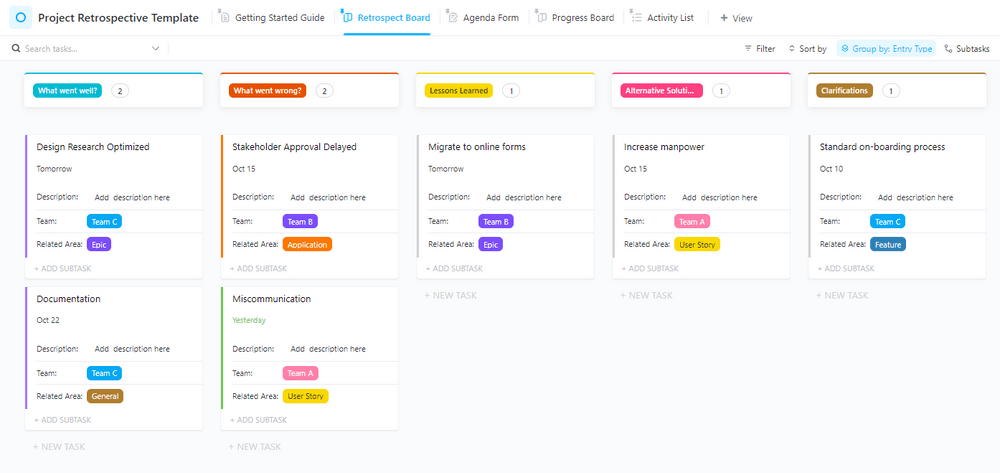
الـ قالب مشروع ClickUp بأثر رجعي يقيّم نجاح المشروع أو فشله بشكل عام مع تحديد التحسينات لتجنب الأخطاء المستقبلية
يعد إغلاق المشروع مهمًا لأنه يحدد ما إذا كان المشروع ناجحًا أو فاشلاً وما يمكن تعلمه. في كثير من الأحيان، يتم قياس المشاريع على أساس معايير الميزانية والجدول الزمني فقط.
هناك ما هو أكثر للنجاح من مجرد أرقام. هل حققنا العلامة على مستوى الجودة؟ هل حققنا أهداف أعمالنا؟ _هذه العوامل مهمة جدًا إذا كنت تريد أن تنجز المشروع بنجاح.
أنواع اختتام المشروع
هناك عدة أنواع لإغلاق المشروع يمكن تنفيذها اعتمادًا على الظروف والأهداف المحددة للمشروع. فيما يلي بعض الأنواع الشائعة:
- الإغلاق العادي: هذا هو النوع القياسي والأكثر شيوعًا لإغلاق المشروع، حيث يتم إكمال المشروع كما هو مخطط له، ويتم إنتاج جميع المخرجات، ويتم تحقيق جميع الأهداف والغايات. يقوم فريق المشروع بإنهاء جميع المهام المتبقية وإجراء المراجعات والموافقات النهائية وإغلاق المشروع رسميًا.
- الإغلاق النهائي: إذا كنت تستخدم برنامجًا لإدارة المشروع، فهذا يعني أنك ستكون قادرًا على وضع علامة على كل بند من بنود العمل على أنه مكتمل. لسوء الحظ، لا تنتهي كل مرحلة من مراحل إغلاق المشروع بهذه الطريقة. فبعض المشاريع يتم إغلاقها قبل أن تتمكن من الانطلاق. عندما يتم إلغاء المشروع عندما يكون على وشك البدء، يُعرف ذلك باسم الإغلاق المبكر.
- الإغلاق الجزئي: في بعض الأحيان، قد يتم إغلاق المشروع جزئيًا عندما يتم الانتهاء من بعض المكونات أو المراحل بنجاح، ولكن لا يزال البعض الآخر قيد التنفيذ. يسمح هذا النوع من الإغلاق باتباع نهج مرحلي، حيث يتم إغلاق الأجزاء المكتملة بينما يستمر العمل المتبقي. وهو يساعد على إدارة التبعيات وتحديد أولويات الموارد بفعالية.
- إغلاق الدمج: في الحالات التي يتم فيها تنفيذ عدة مشاريع ذات صلة في وقت واحد، يمكن إجراء إغلاق موحد. ويتضمن ذلك دمج المخرجات والدروس المستفادة والموارد من مشاريع متعددة في عملية إغلاق واحدة. ويساعد ذلك على ضمان الاتساق ونقل المعرفة والاستخدام الفعال للموارد عبر المشاريع.
- إغلاق التعليق: إذا احتاج المشروع إلى تعليقه مؤقتاً بسبب عوامل خارجية أو قيود تشغيلية، يتم تنفيذ عملية إغلاق التعليق. يتم تعليق المشروع إلى أن تسمح الظروف باستئنافه. أثناء الإغلاق، يقوم الفريق بتوثيق حالة المشروع وموارده وأي إجراءات ضرورية مطلوبة عند استئنافه.
- الإغلاق الفاشل: لسوء الحظ، لا تنجح جميع المشاريع. ويحدث الإغلاق الفاشل عندما يكون المشروع غير قادر على تحقيق أهدافه أو تحقيق النتائج المرجوة. وفي مثل هذه الحالات، يتم إغلاق المشروع دون تحقيق الأهداف المرجوة منه. ومن الأهمية بمكان إجراء تحليل شامل لأسباب الفشل، وتوثيق الدروس المستفادة، وتحديد أي مكونات يمكن إنقاذها أو تعديلات محتملة للمشاريع المستقبلية.
دعونا الآن نتعمق في الخطوات التي يجب اتخاذها عند إغلاق المشروع.
5 خطوات لإتمام عملية إغلاق المشروع ## 5 خطوات لإتمام عملية إغلاق المشروع
فيما يلي خمس خطوات خطوات لإدارة المشروع يجب على فرق العمل اتخاذها عند إغلاق المشروع والحصول على موافقة العملاء وأصحاب المصلحة.
1. تنفيذ مهام الإنجاز
تحتاج النهايات السائبة دائمًا إلى الانتهاء منها خلال المراحل النهائية لأي مشروع.
سيكون قد تم الانتهاء من نواتج المشروع الرئيسية، لذا تأكد من عدم إغفال بنود العمل والأهداف الأصغر حجمًا. يمكن أن يشمل ذلك ما يلي:
- الأصول والمخرجات الإضافية
- وثائق المشروع وفي حالة مخرجات البرمجيات، أدلة المنتجات
- أي تدريب يحتاج إلى تسليم
- تم نقل الملفات والملكية الفكرية التي يمتلكها العميل عند الانتهاء من المشروع
- الفواتير المرسلة والمدفوعة
- أي مهام إدارية أخرى تحتاج إلى القيام بها قبل البدء في عملية إغلاق المشروع
2. الرجوع إلى نطاق المشروع أو الموجز للتأكد من تحقيق الأهداف
الآن بعد أن تم الانتهاء من النهايات العالقة، حان الوقت للرجوع إلى النطاق الأصلي أو الموجز لتقييم ما إذا كانت الأهداف قد تحققت.
يقاس نجاح المشروع مقابل العديد من المعايير ومؤشرات الأداء الرئيسية. وعلى مستوى عالٍ، يتم تقييم معظم المشاريع مقابل عدد قليل من المقاييس الأساسية:
- هل أنجزنا ما توقعه العميل؟
- هل تمت عملية إغلاق المشروع في الوقت المحدد وفي حدود الميزانية؟
- هل كان العميل راضٍ عن الجودة وسعيد بالتوقيع على المخرجات؟
- هل تم تحقيق أهداف وغايات العمل والأهداف التشغيلية؟
شريطة أن يتمكن فريق الإدارة وفريق إدارة المشروع المعني من الإجابة بنعم على معظم⏤⏤ من الناحية المثالية، كل⏤ هذه الأسئلة، فقد كان المشروع ناجحًا. قد يكون تحقيق الأهداف في مشروع واحد مفيدًا إذا كنت ترغب في العمل مع نفس المؤسسة مرة أخرى في مشروع جديد. 🛠️
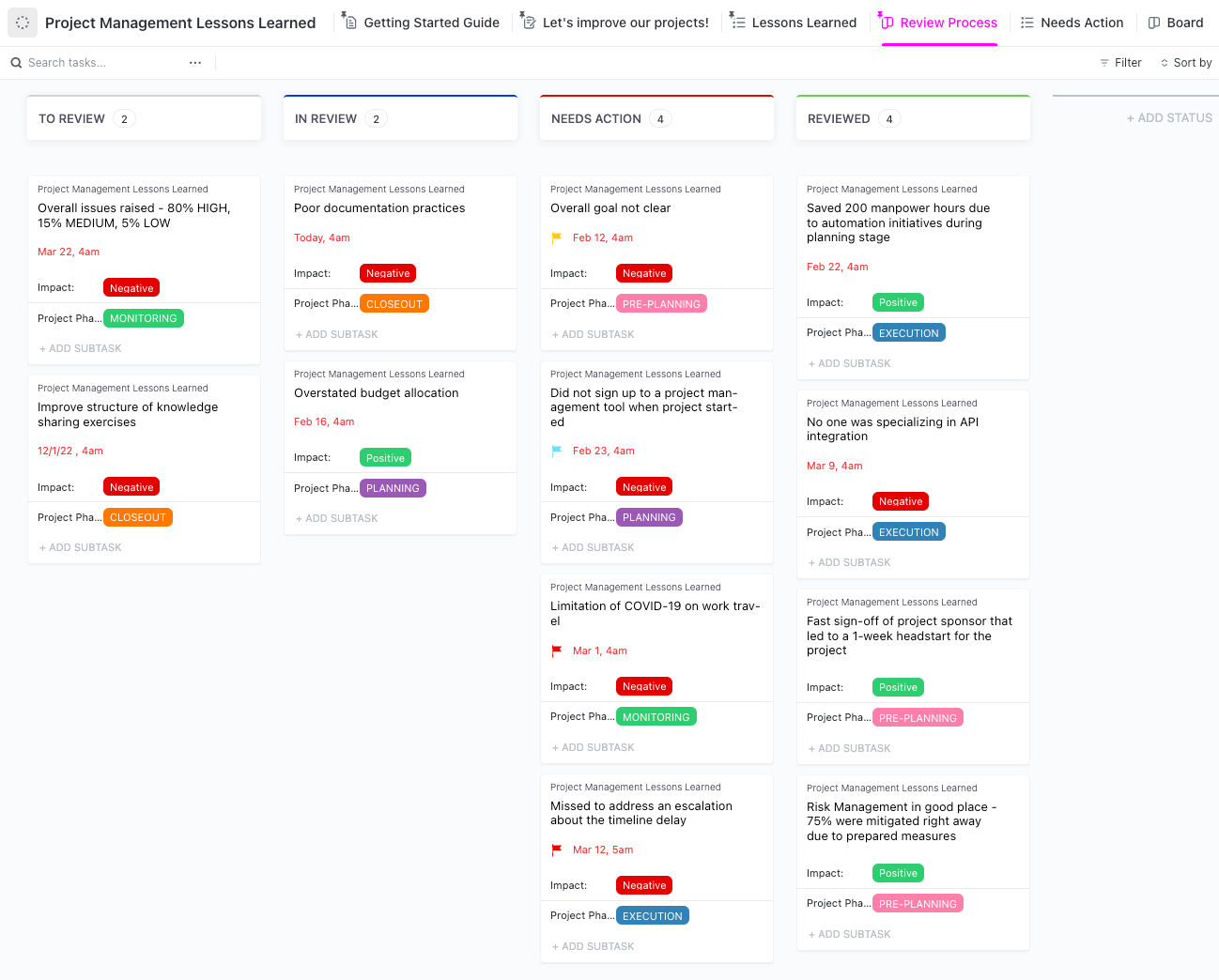
استفد من عرض المجلس في ClickUp نموذج الدروس المستفادة من إدارة مشروع ClickUp لمراجعة وتوثيق وتتبع وتنظيم رؤى مشروعك السابق وتنظيمه
لهذا السبب فإن الأداء عملية ما بعد الوفاة وإغلاق المشروع قيّمة للغاية. يمكنك استخدام هذا الوقت لمراجعة النتائج والدروس المستفادة مع العميل، وكذلك داخليًا.
يمكن لمدير المشروع أيضًا استخدام هذه المعلومات في اجتماع داخلي للتعلم من جميع الاتجاهات بحيث يمكن تطبيق الدروس القابلة للتنفيذ على وثائق المشروع وسير العمل والعمليات المستقبلية.
سيقدّر أعضاء الفريق الملاحظات والتوجيهات حول أداء المشروع لتحقيق أداء أفضل في المرة القادمة.
3. إكمال استخلاص المعلومات من العميل واجتماع التعلم الداخلي بزاوية 360 درجة
تعتبر جلسات استخلاص المعلومات من بين أكثر الأجزاء المفيدة في عملية الإغلاق. يجب أن يخصص مدير المشروع وقتًا لاثنين منها: استخلاص المعلومات الداخلي، المعروف أيضًا باسم اجتماع التعلم بزاوية 360 درجة، واستخلاص المعلومات من العميل واجتماع تسليم المهام.
احرص على عقد الاجتماع الداخلي عبر الهاتف أو الجلسة الشخصية _قبل التحدث إلى العميل. بهذه الطريقة، يكون الجميع في عمليات إدارة مشروعك على نفس الصفحة.
إذا حدث أي خطأ أثناء مرحلة إغلاق المشروع، فمن المفيد معرفة من يتحمل مسؤولية الأخطاء وكيف تم حل المشكلات.
يحتاج مديرو المشاريع إلى استخدام هذا الوقت لمراجعة العملية بأكملها مع فريق المشروع، من البداية إلى النهاية، بما في ذلك المعالم الرئيسية.
خلال الاجتماع الشامل، كن صادقًا مع نفسك ومع فريق المشروع. اسأل نفسك:
- ما الخطأ الذي حدث؟
- ما الذي سار بشكل جيد؟
- هل تم استخدام موارد المشروع بفعالية؟
- ما مدى نجاح الفريق في تنفيذ خطة المشروع؟
- ما الذي تعلمناه؟
- ما الذي يمكننا القيام به بشكل أفضل في المرة القادمة؟

يتيح ClickUp Docs التنسيق المنسق و أوامر الشرطة المائلة للعمل بكفاءة أكبر
قم بتوثيق نتائج الاجتماع الداخلي حتى تكون أكثر استعدادًا لاستخلاص المعلومات في مرحلة اختتام المشروع مع العميل.
سيطرح معظم العملاء أسئلة مشابهة لتلك المذكورة أعلاه. بالإضافة إلى ذلك، سيرغبون في تقييم المخرجات والتسليمات مقابل النطاق والموجز الأولي والأهداف والغايات والأهداف.
يرغب أصحاب المصلحة وكبار القادة الذين يقيسون نجاح المشروع في نهاية المطاف في التأكد من حصولهم على ما دفعوا من أجله. إذا كنت تريد أن تكون دقيقًا، فاكتب كل هذا في تقرير إغلاق المشروع حتى يتمكنوا من مقارنته بخطة المشروع.
نصيحة ماذا لو لم يسير المشروع كما هو مخطط له بالضبط؟ توثيق ما حدث وسبب ذلك أمر بالغ الأهمية. أثناء المشروع، قم دائمًا بتسجيل كل ما يحدث في برنامج إدارة المشروع الخاص بك، وسجل الاجتماعات والمكالمات، واحتفظ بنسخ من رسائل البريد الإلكتروني في نظامك الأساسي أيضًا. بهذه الطريقة لا يمكن للعملاء الاعتراض على الفواتير أثناء عملية إغلاق المشروع.
4. تأكد من اكتمال التوثيق وإتمام عمليات التسليم
هل لديك خطة لتسليم المشروع؟ إذا كان الأمر كذلك، فقد حان الوقت لوضع هذه الخطة موضع التنفيذ كجزء من عملية الإغلاق. إذا لم يكن الأمر كذلك، فيجب على مدير المشروع وضع خطة.
في هذه المرحلة من إغلاق المشروع، غالبًا ما يكون الأمر ببساطة مجرد التأكد من تسليم المستندات والملفات والأصول الأخرى إلى العميل كما هو متوقع. بالنسبة لمخرجات المشروع الأكثر تعقيدًا، مثل البرامج والتطبيقات، قد تتضمن دورة حياة نهاية المشروع الاختبار والتدريب والتصحيح.
عند تسليم أي شيء من موقع إلكتروني إلى برنامج، يحتاج العميل إلى معرفة كيفية عمله. وإلا فإن الأمر يشبه الدفع مقابل سيارة لا يمكنك قيادتها. كجزء من هذا، تأكد من أنك قد أعطيت العميل كل ما يحتاجه:
- وصول على مستوى المسؤول إلى مخرجات المشروع
- الوثائق والأدلة
- المواد التدريبية أو مواد التدريب
- الملكية الفكرية والأصول الأخرى
- الوصول إلى الدعم المستمر حسب الحاجة
عمليات التسليم مفيدة لتأسيس ثقة طويلة الأجل. سيكون من الأسهل الحصول على مشاريع مستقبلية وأنت تعلم أنك أنهيت مشروعاً بنجاح. يمكن أن يكون تقرير إغلاق المشروع مفيداً للمساعدة في تأمين المشروع التالي من نفس الشركة.
كما أن التسليم السلس يؤدي إلى عملاء أكثر سعادة، وأسئلة أقل بعد الإغلاق، وإمكانية تأمين عمل مستمر. ضع علامة على قائمة التحقق من إغلاق المشروع في أداة توثيق المشروع حتى تعرف أنه تم إنجازه.
5. شكر جميع المشاركين وحل فريق المشروع
مع رضا العميل واكتمال المشروع وتسليمه وتمرير وثائق المشروع، لم يتبق سوى شكر الجميع وحل فريق المشروع. 🙌
بصفتك مدير المشروع، تأكد من أن كل عضو في الفريق يعرف مدى جودة أدائه. استوعب الدروس المستفادة. تذكر أن توثق التغييرات في العملية وسير العمل التي سترغب في تنفيذها في المشاريع المستقبلية.
وينطبق الأمر نفسه على أي انتصارات أو اختصارات أو أدوات جديدة تم تجربتها. إذا وجدت شيئًا من شأنه أن يساعدك على إنجاز العمل المستقبلي بكفاءة أكبر، فيمكنك دمج كل ما تعلمته في سير العمل والعمليات في المستقبل.
يمكنك الآن إعادة تعيين أعضاء الفريق إلى مشاريع ومهام وعملاء آخرين.
لجعل إدارة المشروع أسهل، قمنا بتجميع هذه القائمة المكونة من خمسة قوالب لإغلاق المشروع تستحق الحفظ.
5 قوالب مفيدة لإغلاق المشروع
القوالب مفيدة للعديد من سيناريوهات إدارة المشاريع، وسير العمل، والعمليات. وهي ذات قيمة خاصة عندما يمكنك دمجها مع برامج إدارة المشاريع، مثل ClickUp .
1. انقر فوق قالب عرض قائمة إغلاق المشروع قائمة عرض القائمة
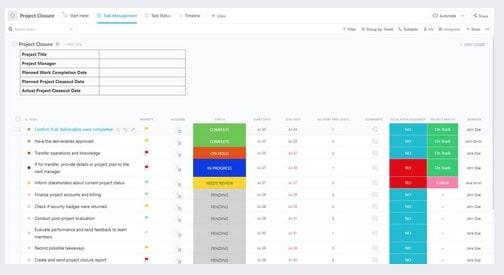
نسخة عرض قائمة من قالب إغلاق مشروع ClickUp
استخدم هذا القالب البسيط قالب عرض قائمة إغلاق المشروع ClickUp قالب عرض القائمة لتتبع كل شيء
من خلال مجموعة من الحقول والحالات المخصصة، يمكنك إضافة هذا القالب إلى ClickUp وجعل هذا القالب هو طريقتك المفضلة لإغلاق المشاريع البسيطة.
يأتي مزوداً بأنواع عرض مختلفة، مثل Gantt، واللوحة، والجدول الزمني. لذلك أيًا كانت الطريقة التي يفضلها فريقك لعرض الجداول الزمنية للمشروع والعمل من خلالها، يمكن تهيئتها بسهولة وفقًا لتفضيلاتك.
2. انقر فوق قالب عرض مهام إغلاق المشروع
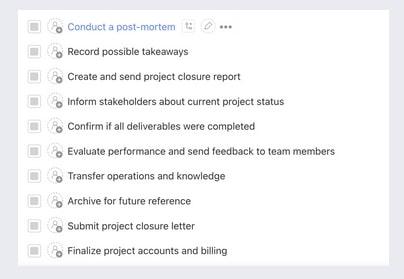
عرض مهام عملية إغلاق المشروع باستخدام ClickUp
نموذج انقر فوق قالب عرض مهام إغلاق المشروع هو بمثابة قائمة مهام بسيطة للمشروع يمكنك استخدامها في ClickUp. استخدمه كقائمة مهام لإغلاق المشروع لضمان التقاط جميع المهام العالقة.
أضف القالب واعرض المشروع بأكمله (أو سلسلة من المهام الفرعية) عنصرًا واحدًا من قائمة المهام في كل مرة. ضع علامة عليها أثناء تقدمك، بهذه البساطة - بصرف النظر عن القيام بالعمل بالطبع! 👀
3. قالب كليك أب 4Ls ريترو
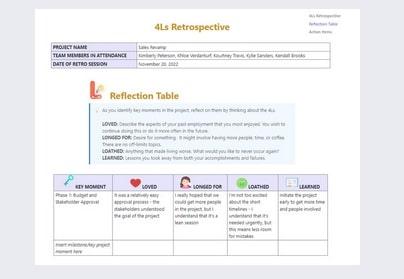
اتبع نهجًا رجعيًا في الاستعراضات بأثر رجعي مع هذا القالب 4L
بالنسبة لأولئك الذين يرغبون في الحصول على المزيد من التعبير عن مهام إغلاق المشروع، إليك نموذج قالب ClickUp 4Ls الرجعية .
يمكن لفريقك أن يقول ما أحبوه وما اشتاقوا إليه وما كرهوه وما تعلموه من المشروع. يأتي هذا النموذج كاملاً مع مساحة للتعمق في الدروس التي تعلمها الفريق.
من المفيد ملء الأحرف "ل" الأربعة، خاصةً عندما تكون المشاريع أكثر تحديًا، حتى يشعر الفريق بأنه مفهوم، ويتم أخذ الملاحظات من قبل مدير المشروع، ويمكن الاستفادة من الدروس القيمة للعمل المستقبلي.
4. قالب نموذج ملاحظات ClickUp
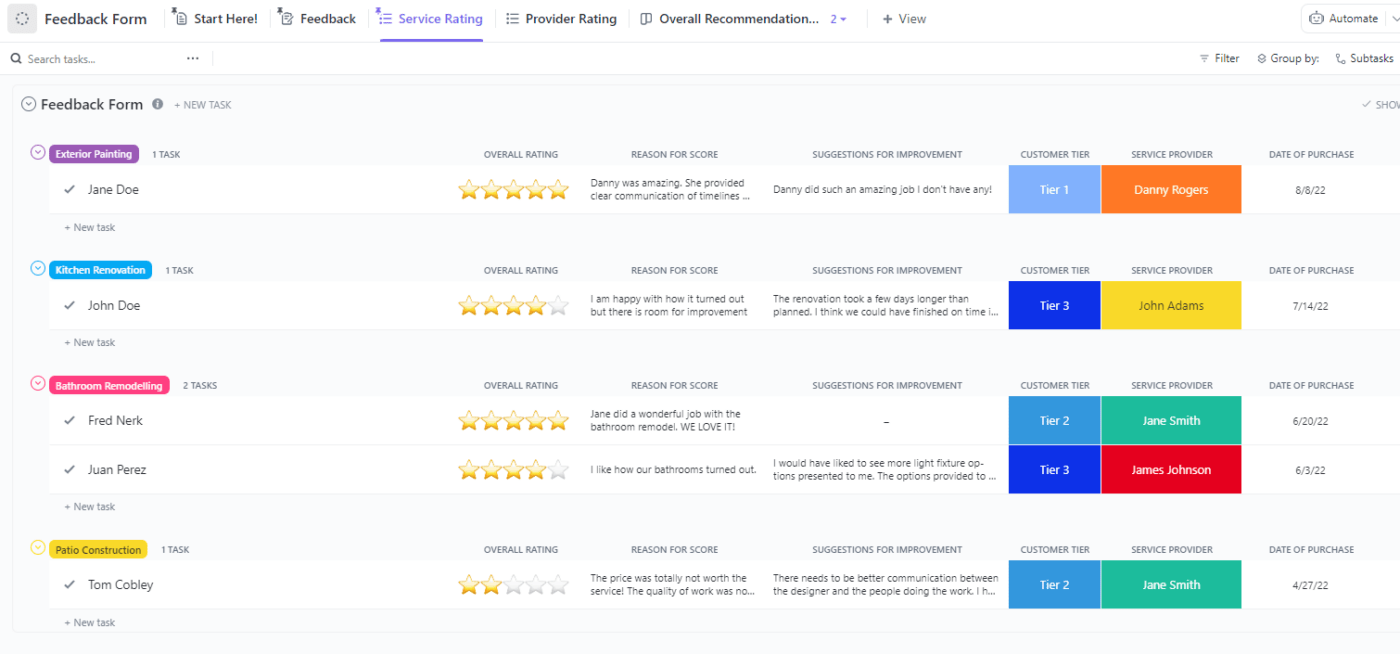
اجمع ملاحظات العملاء وحسّنها من خلال نموذج نموذج الملاحظات القابل للتخصيص لتنظيم الملاحظات في مكان واحد للحصول على رؤى أفضل
نموذج قالب نموذج ملاحظات ClickUp مفيد لجمع آراء العملاء عند اكتمال المشروع وتوقيعه. يمكنك استخدام هذا النموذج للحصول على الملاحظات الداخلية وحتى الشهادات من العملاء.
عادةً ما يقدم العملاء آراءهم في مكالمات استخلاص المعلومات. حتى لو كانت سلبية، فإنها تستحق التسجيل حتى يمكن دمجها في الدروس المستفادة للمستقبل.
وتعتبر الملاحظات والشهادات الإيجابية أكثر قيمة. انشرها على الإنترنت بإذن من عميلك. اجمع هذه الملاحظات باستخدام نموذج الملاحظات الرقمية الخاص بـ ClickUp، وقم بتضمين هذه الدروس في أداة إدارة المشروع الموثوقة.
5. قالب تسليم مشروع ClickUp
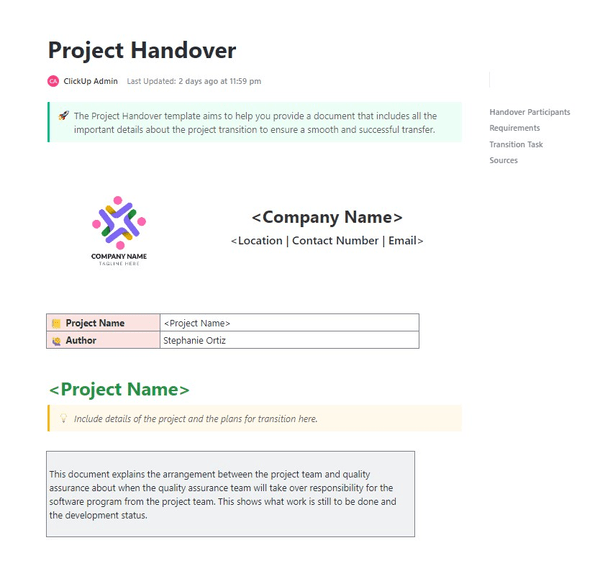
قالب التسليم والتسليم ضروري لإغلاق أي مشروع
هل تحتاج إلى تنفيذ تسليم المشروع ولكن لا تعرف من أين تبدأ؟
لا تقلق إذا لم يكن لديك واحد في إجراءات التشغيل القياسية الخاصة بك. لقد قمنا بتغطيتك مع قالب تسليم مشروع ClickUp .
ضع جميع التفاصيل المهمة في هذا المستند من أجل تسليم ناجح. قم بتضمين الأساسيات مثل تسجيلات الدخول والروابط إلى المجلدات والوثائق وأدلة التدريب وأي شيء آخر سيحتاجه العميل بعد التسليم.
حافظ على سير جميع مشاريعك وتجنب التأخيرات المكلفة أو سوء التواصل. مع قالب تسليم المشروع من ClickUp، سيكون لديك حل شامل لعمليات سلسة لكل أعضاء الفريق المعني.
تبسيط عمليات إغلاق المشاريع باستخدام برنامج إدارة المشاريع
تعد القوالب والعمليات قيمة موفرة للوقت الأدوات التنظيمية عند تشغيل قائمة التحقق من إغلاق المشروع وعناصر الإجراءات، مثل:
- هل تم الانتهاء من جميع المهام؟
- هل تم التوقيع على جميع المخرجات والتسليمات داخلياً ومن قبل العميل؟
- هل قمنا بتسليم المشروع وأي تدريب مرتبط به للعميل؟
- هل تم إغلاق المشروع؟
- هل تم إنجاز جميع مهام إغلاق المشروع والتوقيع عليها من قبل الإدارة؟
ولكن لجعل هذه العملية أكثر سلاسة للجميع، فأنت بحاجة إلى برنامج إنتاجية لإدارة دورة حياة المشروع من البداية إلى النهاية بالكامل. مع برنامج الإنتاجية، يتم إبقاء فريق المشروع بأكمله على رأس العمل ويخضع للمساءلة.
إذا منحتهم إمكانية الوصول، يمكن للعملاء أيضًا تقديم مدخلاتهم وأفكارهم وملاحظاتهم ومواردهم لضمان تسليم المشروع وإغلاقه بنجاح. اشترك في حساب ClickUp المجاني الخاص بك اليوم للاهتمام بدورة حياة المشروع بأكملها من خلال مجموعة برمجيات قوية واحدة، مما يجعل إغلاق المشروع عملية أسهل للجميع.

